Neuroanatomy & Electrochemical Activity (Test 1) G
1/90
There's no tags or description
Looks like no tags are added yet.
Name | Mastery | Learn | Test | Matching | Spaced |
|---|
No study sessions yet.
91 Terms
Glia Cells
nonneuronal cells that support, protect, and nourish neurons of the nervous systems
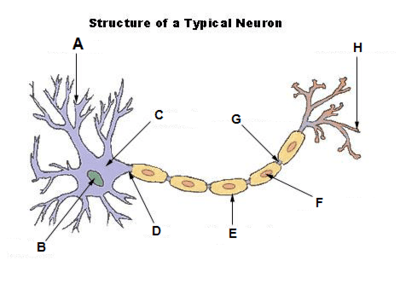
Identify A
A: Dendrites
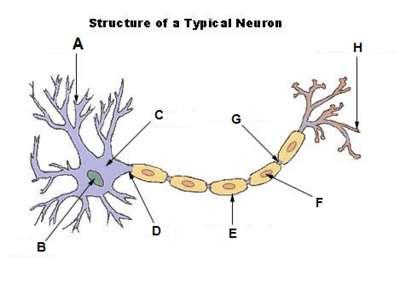

Identify B
B: Nucleus
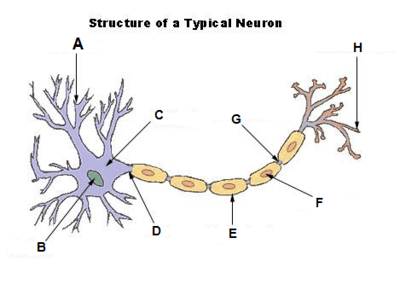

Identify C
C: Soma/Cel Body
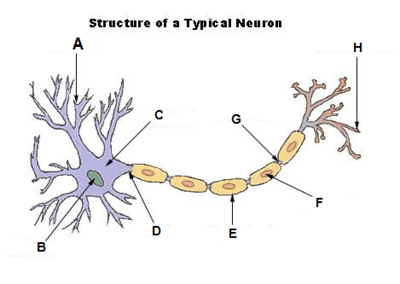
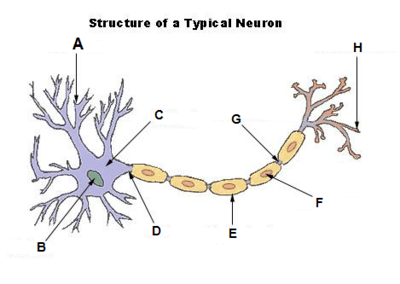
Identify D
D: Axon Hillock
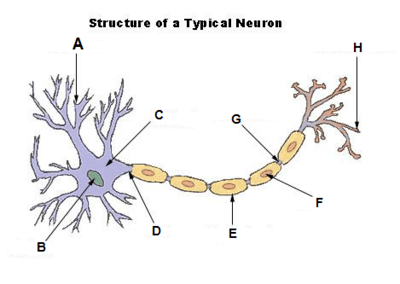
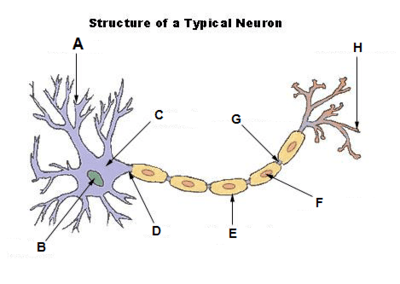
Identify E
E: Axon
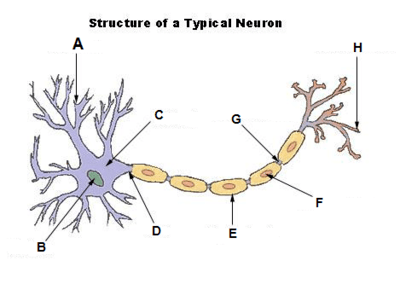
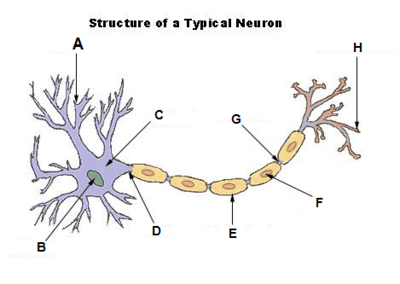
Identify F
F: Myelin
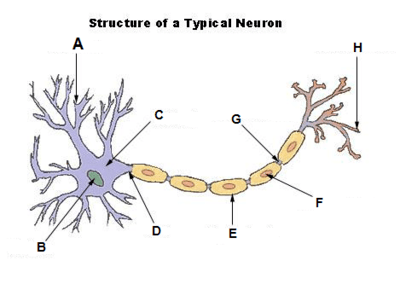
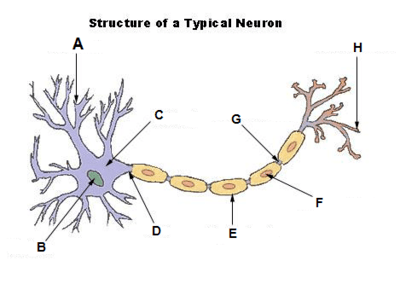
Identify G
G: Node of Ranvier
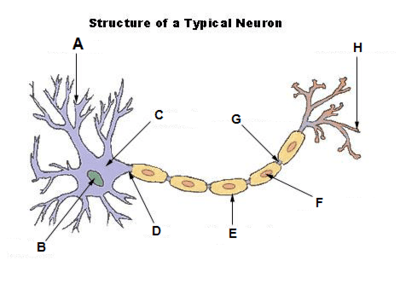

Identify H
H: Terminal Bouton

Name the space between the pre-and-post-synaptic neurons
synaptic cleft
What does the soma do?
the central region of the neuron or cell body, which integrates all the inhibitory and excitatory inputs the nerve receives to decide which one it is getting more of. Should it initiate an action potential/
What are dendrites?
neuronal process responsible for propagating received electrical messages towards the cell body
What is an axon?
the neuronal process responsible for propagating electrical messages away from the cell body towards synaptic terminals
How many axons can a neuron have?
every neuron has one axon, but they can branch a bunch of different ways
Collaterals
branches that come off the single axon on a neuron
Neurites
any neuronal processes: dendrites, axons, collaterals
Where does the axon start?
axon hillock
What are the three ways that a neuron can be classified?
1) Based on the number or neurites
2) Based on shape of dendritic trees
3) Based on neurotransmitter type
Three classifications for neurons based on number or neurites
1) Unipolar: single neurite (ex. DRG)
2) Bipolar: exhibits one axon and one dendrite, both of which may be highly branching (common in sensory pathways)
3) Multipolar: numerous processes; one axon and any number of dendrites (ex. ventral horn neurons
Inhibitory Neurotransmitters
GABA, Glycine, Serotonin
Examples of some neuron classifications based on dendritic trees
stellate (star-shaped), pyramidal, bushy, etc.
How to classify neuron based on neurotransmitter
neurotransmitter name (-ergic)
How many neurotransmitters does a neuron emit
every neurotransmitter can produce and release only a single neurotransmitter
Action Potential
Electrical event
Nerve impulse resulting from brief reversal of membrane potential due to movement of ions across the cell membrane
Neurotransmission
Chemical event
neurotransmitters are chemical messengers that propagate an electrical signal across a synapse (from pre- to posy-synaptic element)
Describe how a neurotransmitter is sent down the axon and the structures involved
1) Nucleus decides to make neurotransmitter, send mRNA to Ribosome
2) Ribosome transcribes proteins for neurotransmitter
3) sends these neurotransmitters to Golgi Apparatus where they are packaged into vesicles and sent down axon
4) arrive at terminal bouton where they can undergo exocytosis
Anterograde Axoplasmic Transport
Movement of molecules from soma, through axon, to terminal bouton
This is done via a kinesin that moves along microtubules
Retrograde Axoplasmic Transport
Movement of molecule from synaptic terminal, through axon, back to some
This is done via dynein that moves along microtubules
Sent back for a breakdown of waste products
Axodendritic Synapse
synapse where axon synapses with a dendrite
Axosomatic Synapse
synapse where axon synapses with the soma (bypass dentrites)
Axoaxonic synapse
Synapse is where an axon synapses with the axon of another neuron
Exocytosis
send something out of a cell
the processes of releasing a neurotransmitter
Endocytosis
take something into the cell
reuptake of unused neurotransmitter
Membrane Potential
uneven distribution of electrical charge across the membrane at a moment in time
What is membrane potential at rest
negative (-60 to -80 mV)
the inside of the neuron is negative compared to the outside
Charge of a cell is always referred to at ________ with respect to _________
inside with respect to the outside
Ion channels are an example of what kind of protein
transmembrane protein
What are the different ion channels
Conformational change happens in response to
Neurotransmitter-Gated (Ligand-Gated): Neurotransmitter (ligand)
Voltage-Gated: electrical activity
Mechanically-Gated: mechanical stress
Sodium-Potassium (ATPase) Pump
moves 3 sodium (NA+) outside while transporting 2 potassium (K+) into neuron
requires energy APT
Do Sodium-Potassium Pumps move ions along or against their concentration gradient
Against
that is why it requires ATP
Describe the ion distribution at the resting membrane potential for
Sodium (Na+)
Potassium (K+)
Calcium (Ca+)
Chloride (Cl+)
Sodium (Na+): more outside
Potassium (K+): more inside
Calcium (Ca2+): more outside
Chloride (Cl-): More outside
Depolarization
cations (positively charged ions) crossing the membrane into the neuron
makes membrane potential less negative
results in excitatory postsynaptic potential
Hyperpolarization
membrane less permeable to cations entry, or more permeable to anion (negatively charges ion) crossing the membrane into neuron
making membrane potential more negative
results in inhibitory postsynaptic potential
Describe the relationship between depolarization and action potential
you can have a depolarization that is not an action potential
Every action potential is a massive depolarization
Electrical Summation
Dendrites are constantly receiving inhibitory and excitatory potentials
These charges are summed to determine if the cell will become more positive (depolarizing it) or negative (inhibiting depolarization)
what is the first event of action potential generation
when net electrical integration results in the axon hillock reaching the threshold (10 to 20 mV above resting membrane) voltage-gated Na+ channels in the axon hillock open, resulting in an all-or-nothing action potential response
Threshold
critical level of depolarization that must be crossed in order to trigger an action potential (all-or-nothing response)
Phases of an Action Potential
1) Threshold
2) Rising Phase: rapid depolarization, influx Na+
3) Overshoot: inside of membrane flips to positive charge
4) Falling Phase: rapid repolarization, voltage-gated Na+ channels close & voltage-gated K+ channels open & K+ rushes out casing potential to become more negative
5) Undershoot: hyperpolarization relative to resting potential due to delated closing or K+ channels
Spatial Summation
Reaches threshold from one excitatory input or multiple excitatory inputs received at the same time
Temporal Summation
Teaches threshold from receiving excitatory input one right after another
Myelin
covering on axon that increases conductivity
Nodes of Ranvier
unmyelinated portion of axon rich in voltage-gated An+ channels
Action potentials skip down axon to these nodes to keep propagating action potential down axon
What causes exocytosis
action potential arrives at terminal bouton causing voltage-gates Ca+ channels to open and Ca+ rushes into neuron stimulating exocytosis
Three ways the excess neurotransmitters can be removed from synaptic cleft
1) reuptake: endocytosis
2: enzyme degradation: acetylcholine eats it all right up
3: passive diffusion: they just travel away
Examples of reuptake inhibors
SSRIs (serotonin) and Cocaine (dopamine & serotonin)
Neurotransmitter Types
Fast
Neuromodulators & Neuropeptides
Nontraditional WHa
Fast Neurotransmitters
can bind to isotropic and G-protein receptors to act in an excitatory and inhibitory manner that act within msec to seconds
Examples of Fast Neurotransmitters
acetylcholine
catecholamines (norepinephrine, epinephrine, dopamine)
GABA
Glycine
Glutamate
Aspartate
Neuromodulators & Neuropeptides
primary bond to G-protein receptors away from synaptic cleft over the course of minutes to days
They generally have a more widespread effect with a longer time course than fast neurotransmitters
Examples of Neuromodulators & Neuropeptides
Substance P (inflammation)
calcitonin (migraine)
endogenous opioids (endorphins, enkephalins, dynorphins)
Nontraditional Neurotransmitters
rapidly diffuse across cell membrane, no need to bind receptor to elicit a response
Examples of Nontraditional Neurotransmitters
Nitric Oxide & Prostaglandins
G-Protein Coupled (metabotropic)
conformational change is enacted via a g-protein on the inside of the phospholipid layer, which can then act on secondary messenger (g-protein gates ion channel & enzymes)
Agonist Drugs
drug binding to receptor & mimics effect of naturally occurring neurochemicals (endogenous)
Antagonist Drugs
drugs that competes/interferes with agonist binding site, thereby blocking receptor activation
Acetylcholine
What kind of neurotransmitter?
Where does it work?
Primary Function?
Fast neurotransmitter
in PNS at neuromuscular junction for contraction of voluntary muscle
What is the receptor for acetylcholine?
cholinergic receptor
Types of cholinergic receptors
Nicotinic: isotropic receptor at skeletal muscle, autonomic ganglia, and CNS
Muscarinic: G-coupled (metabotropic) at cardiac, smooth muscle, and glands
Nicotinic Receptor
type of receptor, Agonist, Antagonist
Cholinergic receptor
Agonist: Nicotinic
Antagonist: Curare
Muscarinic Receptor
type of receptor, Agonist, Antagonist
Cholinergic receptor
Agonist: Muscarine
Antagonist: Atropine
Glutamaterigic Receptors
AMPA: Isotropic receptor for Na+
Kainate: Isotropic receptor for Na+
NMDA: special case
Glutamate
principle fast excitatory transmitter of CNS
NMDA Receptor
What makes it special? Antagonist?
Required agonist binding (glutamate or NMDA) and depolarization
BOTH neurotransmitter and voltage-gated
Once activated lets in Na+ and Ca2+, and lets K+ out
Antagonist: PCP (“angel dust”)
Long Term Potentiation (LTP)
important and critical for learning and memory (making new memories) - induces changes in brain in response to experiences
long-lasting reaction
Excitotoxicity
too much glutamate, too much intracellular Ca+, activating enzymes that damage DNA, membrane, & cytoskeleton
Can cause seizure activity
(Enzymes: endonucleases, phospholipases, protases)
Gabaergic Receptors
isotropic neurotransmitter-gated receptor allowing chloride influx, having an inhibitory effect
Drugs act as agonists for these receptors (ex. alcohol, benzos) resulting in sedative effect
Too little GABA?
hyperexcitability
seizures
unwanted muscle contractions
anxiety
Catecholamines
dopamine, norepinephrine, epinephrine (adrenaline)
Act mainly on G-protein receptors
Tyrosine precursure
Dopamine
Catecholamine
cannot cross the blood-brain barrier
Norepinephrine
catecholamine
locally released in PNS from some sympathetic nerve fibers
Epinephrine
Catecholamine
released as a hormone by adrenal gland, eliciting widespread action
Serotonin
another important amine
Astrocytes
most numerous Glia cells
regulates chemical contents extracellular space & release neurotropic growth factor for functional regeneration
Oligodendrocytes
myelinator of the CNS
has many arms that can wrap around many neurons
Schwann Cells
myelinator of PNS
generally on myelinates a single axon
Microglia
neuronal macrophages
removes debris
primary immune defense of CNS important for pruning
Radial Glia
provides scaffolding for neuronal migration
Ependymal Glia
lines ventricular system and produces CSF
Hypothesis: not enough pruning in early development
could explain autism or schizophrenia
Neuroinflammation
response of CNS to infection, disease, & injury mediated by microglia & astrocytes
too much microglia and neurotropic factor can kill neurons and glia and lead to degeneration
Stem Cell Therapy
found in the hippocampus & lateral ventricles
While we can make stem cells into what we want, we don’t know how to make the brain accept them and make meaningful connections